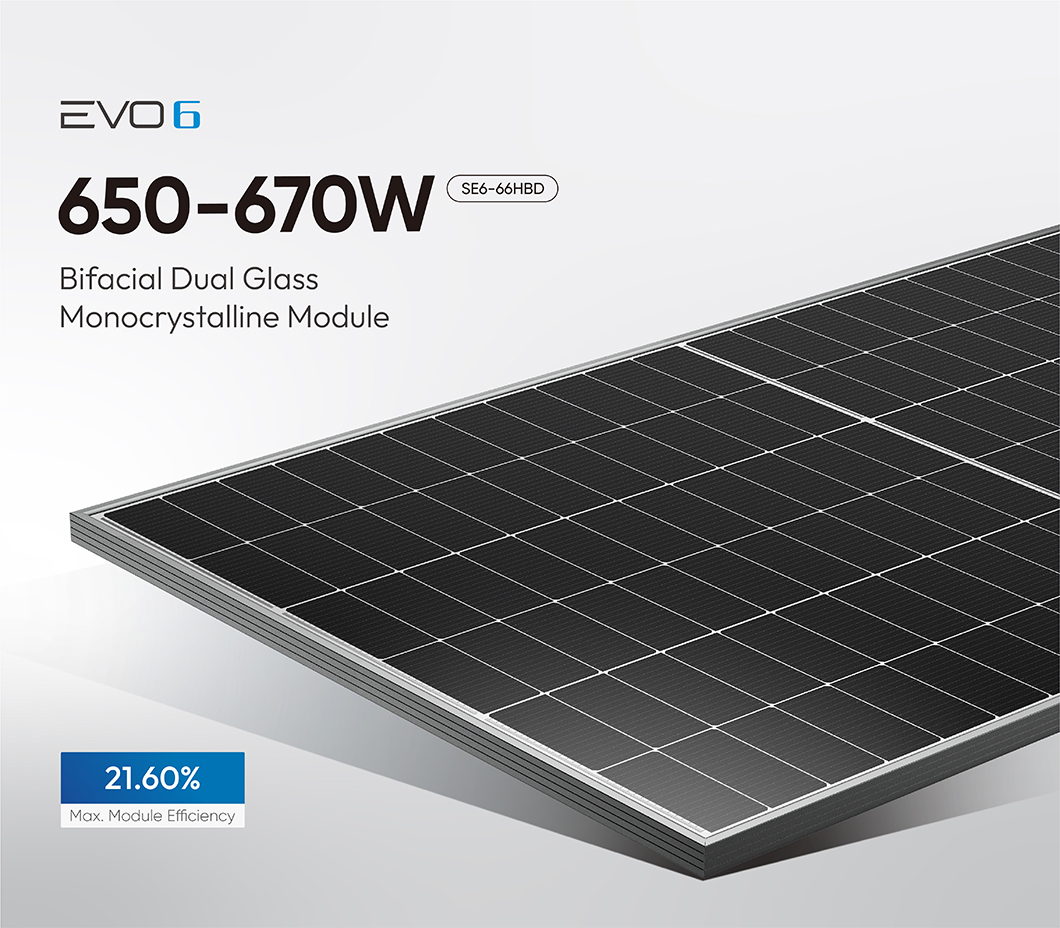EVO 6 Series Bifacial modules combine leading PERC technology, 210mm silicon wafer, and half-cell. 30 years lifespan brings 10-30% additional power generation compared with conventional P-type modules. The SunEvo Bifacial Half-cell Module can reach a power output range between 650W to 670W.
Brand:
SunEvoPower Range:
650W~670WMax. Efficiency:
21.60%Number of Cells:
132 (6×22)Dimensions of Module L*W*H:
2384 x 1303 x 35mmWeight:
38.2kgsFront Side Glass:
High transparency solar glass 2.0mmBack Side Glass:
High transparency solar glass 2.0mmFrame:
Black/Silver, anodized aluminium alloyJunction Box:
IP68 Rated, 3 DiodesCable:
4.0mm2, Portrait: 350mm / Landscape: 1400mmWind/Snow Load:
2400Pa/5400Pa*Connector:
MC compatibleBifaciality:
75±5%EVO6 PERC 650W 655W 660W 665W 670W Bifacial 132 Cells Solar Module
EVO 6 Series Bifacial modules combine leading PERC technology, 210mm silicon wafer, and half-cell. 30 years lifespan brings 10-30% additional power generation compared with conventional P-type modules. The SunEvo Bifacial Half-cell Module can reach a power output range between 650W to 670W.

Electrical Parameters (STC*)
|
Maximum Power (Pmax/W) |
650 |
655 |
660 |
665 |
670 |
|
Maximum Power Voltage (Vmp/V) |
37.60 |
37.80 |
38.00 |
38.20 |
38.40 |
|
Maximum Power Current (Imp/A) |
17.29 |
17.33 |
17.37 |
17.41 |
17.45 |
|
Open Circuit Voltage (Voc/V) |
45.40 |
45.60 |
45.80 |
46.00 |
46.20 |
|
Short Circuit Current (Isc/A) |
18.21 |
18.26 |
18.31 |
18.36 |
18.41 |
|
Module Efficiency (%) |
20.9 |
21.1 |
21.2 |
21.4 |
21.6 |
|
Power Output Tolerance (W) |
0~+5W |
||||
|
Temperature Coefficient of Isc |
+0.05%/°C |
||||
|
Temperature Coefficient of Voc |
-0.28%/°C |
||||
|
Temperature Coefficient of Pmax |
-0.35%/°C |
||||
Evolution of PERC Technology and the Emerging Trend of HJT Technology
In the rapidly evolving world of solar photovoltaics (PV), innovation is the driving force behind increased efficiency and reduced costs. One of the most significant developments in recent years has been the evolution of the Passivated Emitter Rear Cell (PERC) technology, which has played a pivotal role in improving the performance of solar panels. However, a new contender on the horizon, Heterojunction Technology (HJT), is poised to potentially replace PERC in the quest for even greater efficiency and competitiveness.
The Rise of PERC Technology
PERC technology made its debut in the solar industry around 2013, marking a significant leap in the efficiency of solar cells. The key innovation of PERC lies in its ability to reduce recombination losses by adding a passivation layer at the rear surface of the solar cell. This passivation layer effectively traps electrons, allowing them to contribute to the overall current output rather than being lost as heat. By enhancing electron capture and minimizing losses, PERC cells were able to achieve higher conversion efficiencies compared to their predecessors.
Over the years, PERC technology has undergone numerous refinements, leading to increased power outputs and better performance under various conditions. With improvements in cell design and manufacturing processes, PERC has become the industry standard for high-efficiency solar panels, with many manufacturers adopting this technology to produce cost-effective and competitive solar modules.
The Emergence of HJT Technology
While PERC has dominated the solar market for several years, Heterojunction Technology (HJT) is now emerging as a potential successor. HJT combines amorphous and crystalline silicon, offering several advantages over PERC technology. HJT solar cells feature ultra-thin layers of amorphous silicon on both sides, allowing for improved passivation and reduced recombination losses. This design maximizes electron capture and minimizes heat dissipation, resulting in higher efficiency and increased power output.
HJT technology has gained attention for its impressive performance in laboratory settings, achieving efficiencies well beyond those of PERC cells. The promise of HJT lies in its potential to further reduce the cost of solar energy by delivering more power with fewer materials. Additionally, HJT cells have demonstrated improved temperature coefficients, making them more resilient in extreme weather conditions.
The Road Ahead: HJT vs. PERC
While HJT technology shows great promise, it is essential to recognize that PERC technology is firmly established and continues to improve. PERC cells are widely adopted and are currently the workhorse of the solar industry. Transitioning to HJT on a large scale will require time, investment, and further research to address manufacturing challenges and scale up production.
In conclusion, the journey of PERC technology has been marked by significant advancements in solar efficiency and cost reduction. However, the emergence of HJT technology signals a potential shift towards even greater efficiency and competitiveness in the solar industry. As research and development efforts continue, the balance between PERC and HJT will evolve, ultimately determining the future of solar photovoltaics and its role in the transition to a sustainable energy landscape.